Now You Know Textile Finishing: Beautification Process of Fabric
Monday, 21 January 2019
Edit
Textile Finishing: Beautification Process of Fabric

Golam Mawla
Daffodil International University
Department of Textile Engineering
Facebook: https://www.facebook.com/golammawlabd
Email: mawla3140@diu.edu.bd
Daffodil International University
Department of Textile Engineering
Facebook: https://www.facebook.com/golammawlabd
Email: mawla3140@diu.edu.bd
Introduction:
Textile Finishing is a process used in manufacturing of fiber, fabric, or clothing. In order to impart the required functional properties to the fiber or fabric, it is customary to subject the material to different type of physical and chemical treatments. For example wash and wear finish for a cotton fabric is necessary to make it crease free or wrinkle free. In a similar way, mercerizing, singeing, flame retardant, water repellent, water proof, antistatic finish, peach finish etc are some of the important finishes applied to textile fabric.
Textile Finishing:
Textile finishing is a term commonly applied to different process that the textile material under go after pretreatment, dyeing or printing for final embellishment to enhance their attractiveness and sale appeal as well as for comfort and usefulness.
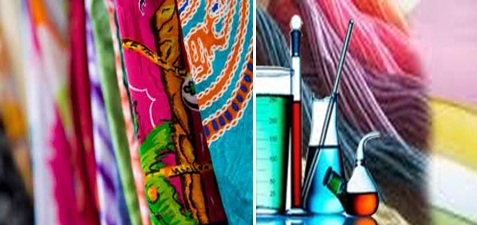 |
| Fig: Textile finished fabric |
The aim of finishing is to render textile goods fit for their purpose or end use. Besides that, finishing can be done for achieving the following purposes-
a) To improve fabric attractiveness.
- By modification of fabric appearance (Calendaring, Optical brightening)
- By altering fabric handle (Softening, Stiffening)
- Control of fabric dimension (Sanforizing, Compacting)
- Protection of fabric (Flame proofing, Water proofing)
- Improved performance (Water repellency, Raising)
- Easy care properties (Resin finish, Crease recovery)
 |
| Fig: Classification of Finishing |
- Physical/Mechanical.
- Chemical.
Mechanical Finishes usually involved specific physical treatment to a fabric surface to cause a change in fabric appearance. This is also known as dry finish.
It's two types
1. Temporary :
A finish which is not stable and goes off after the first wash is known as temporary finish and these finishes disappears during subsequent washing and usage.(Calendaring, embossing, Starching, Softening etc)
2. Permanent/Durable:
If the finishing effect in the fabric does not disappear and remains unaffected through all the conditions of wear and washing treatments, then the finish is said to be permanent finish.( (Raising, Sanforizing, etc)
Describe Some Mechanical Finishing:
Calendaring:
Calendaring is defined as the modification of the surface of a fabric by the action of heat and pressure. The finish is obtained by passing the fabric between heated rotating rollers (Smooth or Engraved) when both speed of rotation and pressure applied are variable.
 |
| Fig: Calendaring fabric |
- To improve the fabric handle and to impart a smooth silky touch to the fabric.
- To compress the fabric and reduce its thickness.
- To reduce the air permeability by closing the threads.
- To increase the luster.
- To reduce the yarn slippage.
- Surface patterning by embossing.
Durable finish imparted on man-made fibres and knitted fabrics by employing heat and pressure to shrink them to produce a crêpey and bulky texture.
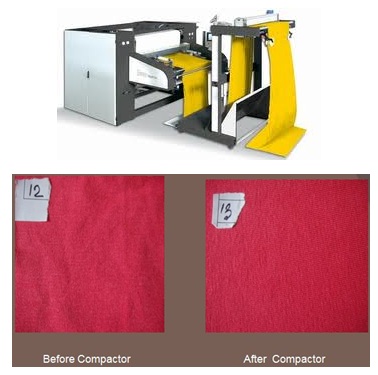 |
| Fig: Compacting fabric |
Sanforizing is a process where by the fabric is run through a sanforizer; a machine that has drums filled with hot steam. This process is done to control the shrinkage of the fabric.The fabric is given an optimum dimensional stability by applying mechanic forces and water vapour.
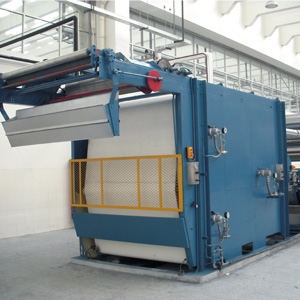 |
| Fig: Sanforizing machine |
This process is carried out by means of a roller coated with abrasive material. Sueding is a mechanical finishing process in which a fabric is abraded on one or both sides to raise or create a fibrous surface. This fibrous surface improves the fabric appearance, gives the fabric a softer, fuller hand, and can mask fabric construction and subdue coloration. Special type of raised surface fabric is corduroy Sueding, sanding- creates softer hand of fabric.
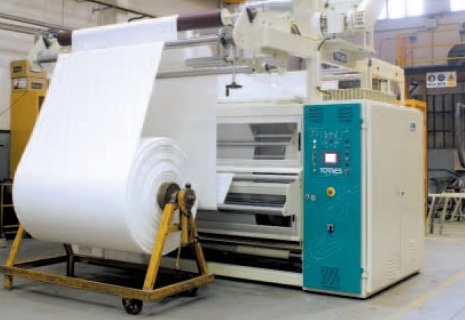 |
| Fig: Sueding fabric |
The raising of the fiber on the face of the goods by means of teasels or rollers covered with card clothing (steel wires) that are about one inch in height. Action by either method raises the protruding fibres and causes the finished fabric to provide greater warmth to the wearer, makes the cloth more compact, causes the fabric to become softer in hand or smoother in feel. Napped fabrics include blankets, flannel, unfinished worsted, and several types of coatings and some dress goods.
 |
| Fig: Raising finishing |
A machine or apparatus for stretching or stentering fabrics. The purpose of the stenter machine is to bringing the length and width to pre determine dimensions and also for heat setting and it is used for applying finishing chemicals and also shade variation is adjusted. The main function of the stenter is to stretch the fabric width wise and to recover the uniform width.
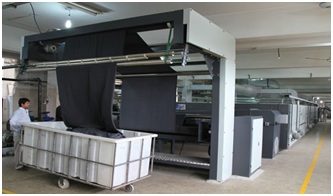 |
| Fig: Stentering machine |
- Heat setting is done by the stenter for lycra fabric, synthetic and blended fabric.
- Width of the fabric is controlled by the stenter.
- Finishing chemical apply on fabric by the stenter.
Shearing is an important preparatory stage in the processing of cotton cloth. The objective of "Shearing" is to remove fibers and loose threads from the surface of the fabric, thus improving surface finish.
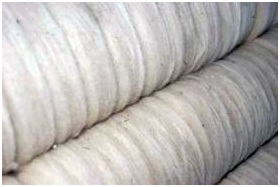 |
| Fig: Shearing fabric |
The finishes applied by means of chemicals of different origins, a fabric can receive properties. Chemical finishes are usually applied to fabric by padding followed by curing and drying. These are also called as wet finishes. Chemical is used for it.
It's also two types
1. Temporary :
A finish which is not stable and goes off after the first wash is known as temporary finish (Starching, Weighting, Softening etc.)
2. Permanent/Durable:
Permanent finishes usually involve a chemical change in fibre structure and will not change or alter throughout the life of a fabric(Mercerizing, Resin, Water proof, Fire proof etc Soil Release)
Describe Some Chemical Finishing:
Softening:
Softening treatment is one of the most important chemical after treatments in the textile industry. Softening is carried out when the softness characteristics of a certain fabric must be improved, always carefully considering the composition and properties of the substrate.
 |
| Fig: Softening treatment |
Elastomeric finishes are also referred to as stretch or elastic finishes and are particularly important for knitwear. These finishes are currently achieved only with silicone-based products. The main effect is durable elasticity, because not only must extensibility be enhanced, but recovery from deformation is of crucial importance. After all stresses and disturbing forces have been released, the fabric should return to its original shape.
 |
| Fig: Elastomeric finishes |
Crease Resistant Finishes are applied to cellulose fibres (cotton, linen and rayon) that wrinkle easily. Permanent Press fabrics have crease resistant finishes that resist wrinkling and also help to maintain creases and pleats throughout wearing and cleaning.
 |
| Fig: Crease Resistant Finishes |
With the increasing use synthetic fibbers for carpets and other materials in public places, anti-microbial finishes have assumed importance. Anti microbial finish Eco-friendly anti microbial finishing agent for cotton fabrics & Garments. Useful for eliminating bacterial growth due to sweat.
Soil Release Finishes:
Prevent soil and stains from being attracted to fabrics. Such finishes may be resistant to oil-boure or water-bourne soil and stains or both. These finishes attract water to the surface of fibres during cleaning and help remove soil. Soil release finish increases the hydrophilicity of the material and increases wetability.
Peach finish:
Subjecting the fabric (either cotton or its synthetic blends) to emery wheels, makes the surface velvet like. This is a special finish mostly used in garments.
 |
| Fig: Peach finish |
Anti pilling finish reduces the forming of pills on fabrics and products made considerable strength, flexibility and resistance to impact. Anti pilling finish is based on the use of chemical treatments which aim to suppress the ability of fibers to slacken and also to reduce the mechanical resistance of synthetic fiber.
 |
| Fig: Anti pilling finish |
They are applied to combustible fabrics used in children's sleepwear, carpets and curtains and prevent highly flammable textiles from bursting into flame. Polyester fabrics can be made flame resistant by treatment with an aqueous emulsion of xylene soluble 2,3-dibromopropyl phosphate in a pad-cure sequence.
 |
| Fig: Flame Retardant Treatment |
Waterproof Finishes allows no water to penetrate, but tend to be uncomfortable because they trap moisture to the body. Recently, fabrics have been developed that are waterproof, yet are also breathable that is more comfortable.
 |
| Fig: Waterproof Finishes |
Water-repellent finishes resist wetting. If the fabric becomes very wet, water will eventually pass through. Applied to fabrics found in raincoats, all-weather coats, hats, capes, umbrellas and shower curtains.
 |
| Fig: Water-repellent finishes |
Finishing is most efficiently carried out on fabrics. Now a day it's apply all types of fabrics. Today it also applies on different types of garments. So, it’s the very important process and the final treatment process for textiles materials. We have learnt about different textile finishing. It is very important assignment for us. It will be helpful in our Industrial or practical life.
Reference:
- http://textilefashionstudy.com
- http://mytextilenotes.blogspot.com
- http://www.slideshare.net
- http://www.onlineclothingstudy.com
- http://www.tikp.co.uk
- http://www.textileschool.com
- http://www.thesmarttime.com/index.html